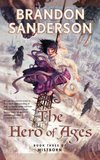
Ever since the Lord Ruler was killed in the first Mistborn book, things have been getting worse. It all comes to a head in The Hero of Ages. The world is quite literally ending.
Sanderson’s strength continues to be his world building. We get a lot more details this time around. We learn of a few more Allomantic metals. We learn all about the third metallic art (only previously hinted at): Hemalurgy. On top of that, we expand on what exactly the Koloss and Kandra are, what abilities they have, and how they came to be. It’s crazy awesome how it all fits together and would be well worth the read just got that.
On top of that, there is a strong plot that pulls you through the book. As mentioned, the world is ending. There’s still hope, all throughout the book, but as a reader I honestly didn’t know how they were going to make their way out of the problems stacking up in front of our heroes.
One thing that I realized by the end of this book is that the entire Mistborn trilogy of how much the story is actually Sazed’s. He begins a Steward and Keeper, a collector of religions. He manages to believe in them all, setting truth and value everywhere. By The Hero of Ages, Sazed is an atheist. He cannot find a religion without flaws. And at the end Sazed _becomes_ a god. He has gone full circle, once again setting the grains of value in all religions. Its a powerful story and really makes one think.
Overall, it’s a great book and a great conclusion to the first Mistborn trilogy. Even better: there is more!
One oddity from near the end: Elan determines that sixteen percent of people are becoming mistings. Sixteen percent of those can burn atium. It's a cool twist... But doesn't quite make sense. Atium isn't one of the sixteen Allomantic metals, it's one of the two God Metals. So why does it fit into Preservation's scheme? It's not story breaking, but it is odd.